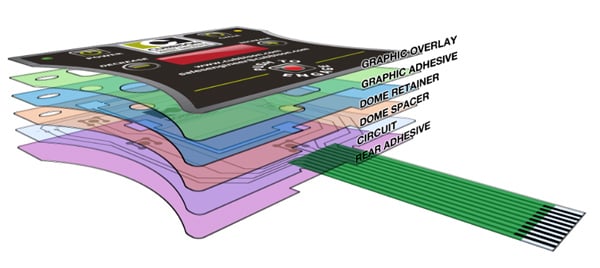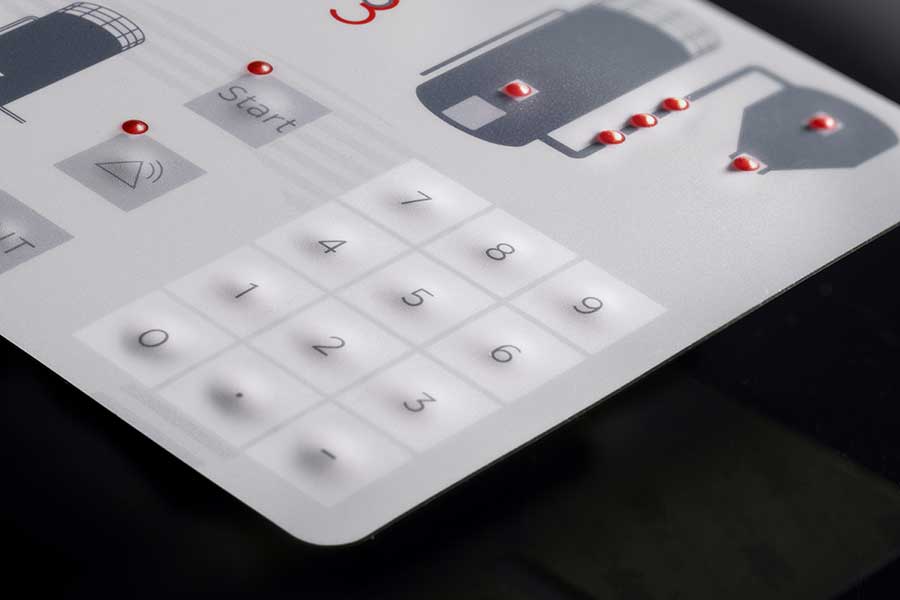Membrane Switches vs. Conventional Switches: What You Need to Understand
Membrane Switches vs. Conventional Switches: What You Need to Understand
Blog Article
Membrane Layer Switch Over Technology: The Key to Trusted and Cost-Effective Interfaces
Membrane switch technology has emerged as an essential element in the design of user interfaces, providing both reliability and cost-effectiveness throughout a varied variety of applications. As we check out the complex benefits of membrane layer switches, their potential for innovation raises inquiries about future applications and evolving patterns.
Comprehending Membrane Switch Technology
Membrane layer switch innovation is a commonly utilized user interface option in different electronic tools, supplying a smooth mix of performance and design. This modern technology includes several layers of products, typically consisting of a graphic overlay, spacer layer, and a circuit layer. The visuals overlay shows the interface components, while the spacer layer separates the circuit layer from the overlay until a user turns on a button.
When pressure is related to the overlay, the circuit layer finishes the electric circuit, sending a signal to the tool. This device enables for numerous setups, including responsive feedback and backlighting alternatives, enhancing individual interaction. Membrane buttons are normally manufactured making use of long lasting materials such as polyester or polycarbonate, ensuring longevity and resistance to ecological aspects like wetness and dirt.
The flexibility of membrane layer switches over allows their application in diverse sectors, consisting of clinical gadgets, customer electronics, and commercial controls. Their small layout enables combination into space-constrained environments, offering a reliable interface without endangering visual charm. Recognizing the complexities of membrane layer switch innovation is crucial for producers and developers seeking to develop dependable and efficient human-machine user interfaces.
Key Benefits of Membrane Layer Buttons
While different user interface solutions exist, membrane changes deal distinctive advantages that make them a favored option in various applications. Among the primary benefits is their sturdiness; membrane layer buttons are designed to endure rough environmental conditions, including dampness, dust, and temperature changes, guaranteeing lasting efficiency. This strength dramatically reduces the need for frequent substitutes, thereby lowering general upkeep costs.

Furthermore, membrane layer buttons are lightweight and compact, making them suitable for applications where room is restricted. Their inconspicuous style contributes to a streamlined look without endangering performance.
Cost-effectiveness is likewise a significant advantage, as the production process for membrane changes tends to be more economical compared to conventional mechanical buttons. This affordability, combined with their integrity and simplicity of setup, positions membrane switches as a sensible service for a variety of markets seeking reliable and efficient individual interfaces.
Applications Across Numerous Industries
How do membrane layer buttons adapt to the varied requirements of numerous markets? Membrane layer switch modern technology is progressively recognized for its convenience, making it suitable for a wide variety of applications throughout multiple markets. In the medical field, membrane buttons are utilized in diagnostic tools and client surveillance devices, where their resilience and ease of cleaning are critical for preserving health standards. The automobile sector employs these switches in dashboards and control board, providing a structured aesthetic while ensuring easy to use procedure.
In customer electronic devices, membrane switches give a compact option for remote controls and home appliances, improving individual experience with instinctive layout. In addition, the industrial market leverages membrane layer buttons for equipment control board, taking advantage of their resistance to harsh environments, such as moisture and dust.
Armed forces and aerospace applications likewise make use of membrane layer buttons for their dependability and capacity to hold up against severe problems, making certain operational efficiency in important scenarios. Furthermore, the food and beverage industry embraces these buttons for automated systems, where sanitation and ease of operation are paramount. Eventually, membrane buttons are customized to satisfy the one-of-a-kind demands of each market, confirming their important role in contemporary innovation user interfaces
Style and Personalization Options

In the realm of membrane layer switch innovation, design and modification choices play a pivotal duty in improving functionality and customer communication. These switches can be customized go right here to satisfy specific operational demands and visual preferences, making them flexible elements in numerous applications.
Among the primary modification options is the format of the switch itself, which can be made to fit distinct user interfaces and ergonomic factors to consider. By adjusting the form, size, and arrangement of switches, producers can produce instinctive designs that promote ease of use. In addition, the consolidation of various shades and graphic overlays permits for branding and enhanced presence, guaranteeing that customers can rapidly identify functions.
In addition, membrane buttons can be engineered with different responsive feedback devices, such as raised buttons or distinct clicks, to boost the user experience. Different products can additionally be chosen for durability and ecological resistance, resolving elements such as wetness, temperature level fluctuations, and chemical exposure.
Inevitably, the extensive style and modification options offered in Your Domain Name membrane layer my latest blog post button technology empower services to develop customized solutions that not only satisfy practical needs yet also align with their branding and operational demands.

Future Trends in Membrane Switches
As membrane switch innovation continues to evolve, future fads are increasingly concentrated on improving customer experience and incorporating sophisticated capabilities. One significant trend is the integration of touch-sensitive and capacitive innovations right into standard membrane layer buttons. This development permits even more intuitive interface, offering tactile comments while preserving a smooth design.
Another emerging trend is using eco pleasant products, driven by the expanding demand for sustainable manufacturing methods. Makers are seeking to decrease their carbon footprint by utilizing recyclable substrates and low-impact inks, aligning with global sustainability goals.
In addition, the rise of the Internet of Things (IoT) is motivating the unification of clever features right into membrane layer buttons. Improved connection options will certainly allow gadgets to interact with each other, allowing for smooth integration right into wider systems.
Additionally, innovations in printing modern technologies, such as digital printing, are permitting higher style versatility and customization. This enables manufacturers to generate complex layouts and dynamic shades cost-effectively.

Final Thought
Finally, membrane layer switch modern technology represents a vital advancement in interface design, supplying considerable benefits in longevity, modification, and cost-effectiveness. Its widespread applicability across varied sectors highlights its relevance in modern-day technology. As developments proceed to emerge, specifically in touch-sensitive user interfaces and sustainable products, the possibility for membrane switches over to improve user experience and performance remains encouraging. Continued expedition of this technology will likely yield better improvements and expand its extent in future applications.
Report this page